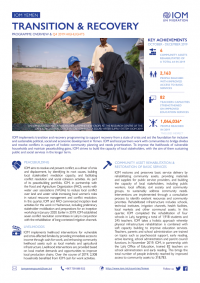IOM Yemen: Transition and Recovery – Programme Overview and Q4 2019 Highlights
IOM implements transition and recovery programming to support recovery from a state of crisis and set the foundation for inclusive and sustainable political, social and economic development in Yemen. IOM and local partners work with communities to bridge divides and resolve conflicts in support of holistic community planning and needs prioritization. To improve the livelihoods of vulnerable households and maintain peacebuilding gains, IOM strives to build the capacity of local stakeholders, with the aim of them sustaining public and social services in the longer term.
PEACEBUILDING
IOM aims to resolve and prevent conflict, as a driver of crisis and displacement, by identifying its root causes, building local stakeholders’ mediation capacity, and facilitating conflict resolution and social cohesion activities. As part of its peacebuilding portfolio, IOM, in partnership with the Food and Agriculture Organization (FAO), works with water user associations (WUAs) to reduce local conflict over land and water while increasing local women’s roles in natural resource management and conflict resolution. In this quarter, IOM and FAO commenced inception level activities for this work in Hadramout, including preliminary stakeholder mobilization and preparations for an inception workshop in January 2020. Earlier in 2019, IOM established seven conflict resolution committees in Lahj in conjunction with the rehabilitation of long-contested irrigation channels.
LIVELIHOODS
IOM implements livelihood interventions for vulnerable and crisis-affected families by providing immediate access to income through cash-for-work, and enhancing community livelihood assets such as local markets and agricultural infrastructure. Livelihood interventions are provided based on local market demands and opportunities to improve local production chains. Over the course of 2019, 2,308 households benefited from IOM cash for work activities.
COMMUNITY ASSET REHABILITATION AND RESTORATION OF BASIC SERVICES
IOM restores and preserves basic service delivery by rehabilitating community assets, providing materials and supplies for public service providers, and building the capacity of local stakeholders, including public workers, local officials, civil society and community groups, to sustainably address community needs. Interventions are implemented through a consultative process to identify existent resources and community priorities. Rehabilitated infrastructure includes schools, technical institutes, irrigation channels, health facilities, local markets and other communal assets. In this quarter, IOM completed the rehabilitation of four schools in Lahj, targeting a total of 1,918 students and 245 teachers. IOM takes a holistic approach whereby physical infrastructure rehabilitation is combined with soft capacity building to improve education services. Teachers, parents and school administration are trained on topics such as psychosocial support, early reading, active learning, school administration and parent council functions. In November 2019, IOM, in partnership with the Lahj Office of Education, trained 82 teachers on school administration and early reading. This brings the total number of people indirectly reached by improved access to community assets to 318,783.

